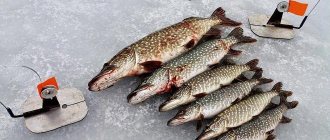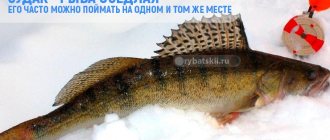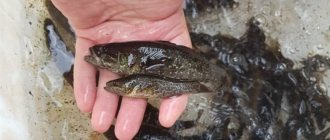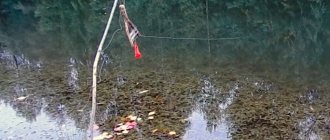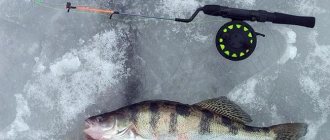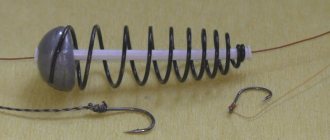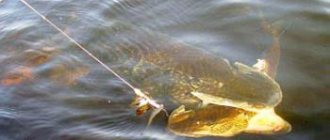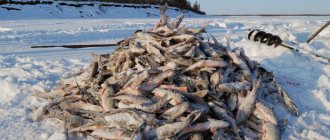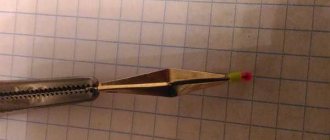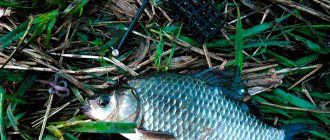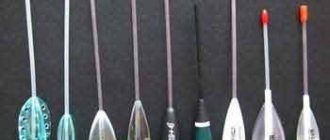In winter, pike fishing using flags using live bait as bait has become widespread. In winter, pike, in search of fry, come to shallow water, so the optimal depths are from 1.5 to 2 meters. At these depths there are quite large specimens, which are caught on the hooks of the installed vents.
The device of the girder
They mainly use a girder with a flag, which, when bitten, seems to shoot and signal the angler about the bite. The red color of the flag can be seen very far away against the background of white snow or ice. It is structured as follows:
- A reel and a flag attached to a 30-40 centimeter flexible base are attached to a base made of wood or other material (but not metal). To do this, you can use a flexible metal (or composite material) pin, 2-3 millimeters thick. The longer this pin, the farther you can see it. Typically, fishing is not limited to the installation of one girder - they are installed severally, covering a wide area. The distance between the outermost rods can reach 100 meters, so it is very important that the bite can be noticed at such a distance.
About 20-30 meters of fishing line with a diameter of 0.1 mm (preferably braid) is wound onto the reel. It is very sensitive and will provide a good hook, and the small diameter will not alarm the predator.
A leash (made of string or leash material) about 20 cm long with a sharp hook at the end (preferably a tee) is attached to the end of the fishing line. At a distance of 5-6 cm from the leash, a weight is attached that will lower the bait to the bottom.
- During installation, the flag is bent and wound by the reel handle. Here you very correctly need to set the flag, which may not work if there is a bite. It is installed so that when the reel is unwinded, it is freed from the hook and stands at attention.
Main components
The equipment of the winter vent includes:
- Main line
- Cargo
- Stopper
- Carbine
- Leash
- Hook
The correct choice of components allows you to successfully hook and avoid the fish falling off when retrieving. After all, you have to remove it from the hole directly by the fishing line, and not with the help of a landing net, as happens when fishing with a fishing rod. Therefore, we will consider in detail what characteristics the above listed components should have.
Working line
Among the main characteristics of the working line are:
- Thickness
- Length
- Node type
- Material
When going for pike, you need to equip the fishing reel with about 15-30 meters of fishing line. This is explained primarily by the fact that such a predator is extremely careful, and while it swallows the fish to a level sufficient for hooking, it swims away 2-3 tens of meters. Moreover, according to the practice of experienced fishermen, she exhibits such habits even if the reservoir is only a meter deep.
The deeper the bottom, the more fishing line you will need. There is a simple calculation formula: line length = depth + 10 meters
.
The exception is stumpy places (which will be discussed below). For small fish, the length of the line is significantly reduced. For example, for rotan 1-2 meters is enough. Tips for a fisherman: Which fishing line to choose for a spinning rod for pike - Features of the choice
The unwinding force of the reel is not always the same. Sometimes it can become so intense that the line simply falls off. Therefore, when winding after the first turn, the line should be secured using a standard self-tightening loop, or an arbor
(axial node).
See the picture below:
To equip a winter fishing line, the fishing line material must meet the following requirements:
- Low elongation
- Minimum memory
- Resistance to minor damage and cuts from the edge of the hole
- Saving properties
Special winter monofilament fishing lines made of nylon or their analogs made of fluorocarbon and fluorocarbon have parameters that are as close as possible to these standards.
We make a slot to the center - the fishing line will be threaded into this slot. A hole with a diameter of 5-10 mm is drilled in the center and must be sanded so that the fishing line passes freely into the central hole.
Choice of live bait
You can use crucian carp, gudgeon or small perch as live bait: it all depends on atmospheric conditions. If you plan to fish at depth, then crucian carp is suitable, if in the water column, then preference can be given to perch, and gudgeon is suitable for fishing both at depth and in the water column. In order not to make a mistake in your choice, it is better to take several types of live bait with you - this will expand the boundaries of the experiment and make it possible to experimentally determine which bait fish the predator prefers today. In this case, there should be live bait, both small and large. You need to start fishing with smaller live bait, and then move on to larger ones: usually small fish come to the biting place, and then larger ones.
Advantages and disadvantages of fishing with flags
Catching pike with flags is a synonym for the method of catching pike with girders, but girders can be either designed for passive fishing, and then they are called postavukhas , or they can be equipped with bite alarms - flags, and this is a completely different, active fishing. By the way, not only girders, but also pike traps , but this method of fishing is considered poaching.
Fishing for pike with flags has the following advantages:
- the ability to catch a passive predator that does not respond to artificial baits;
- the ability to visually observe the moment of a bite and react quickly;
- no need for long journeys.
Flaws:
- low mobility of fishing, since the angler has the opportunity to fish in a much smaller water area than during sea fishing with artificial baits;
- cumbersome equipment;
- It’s inconvenient to fish in severe frost, since not only your bare hands, with which you have to bait the bait, freeze, but also the holes, which you have to constantly clean.
Fishing tactics
Some nuances of fishing tactics were outlined above, which are a very small component that can be supplemented with the following tips:
- First, deeper places are fished, where the pike begins to show its activity, gradually moving to shallower areas. Pike are most active in places littered with fallen trees and snags.
- Installation of a large number of vents (from 10 pieces) covering a wide range of depths. This will make it possible to determine the horizon on which the pike is currently showing its activity. In this case, you can constantly change the type of live bait. In a word, you have to fish in a very dynamic mode. Fishing (winter for pike) can be classified as one of the types of active recreation that adds years to life.
Knitting knots
A self-tightening loop has a serious advantage compared to others - it simply stretches under the load and the larger it is, the tighter the loop itself is tightened. Let's touch on some interesting ways to properly tie a fishing line to a spool.
Photo 1. Self-tightening knot.
First, let's touch on the popular method using a large reel (for bottom fishing). Such a reel is quite convenient for working over long distances, but, unfortunately, it requires a lot of fishing line for winding.
In this case, if the reel is suitable, it is better to start winding with a cheap one and gradually switch to a higher quality one - braid or monofilament.
But it is advisable to wind a regular cord around the spool of a small spinning reel.
First method
We begin to act as follows:
- We take the fishing line and wrap it around the reel spool, while it is advisable to leave a small piece necessary for making a loop.
- We first wrap the loop with the main fishing line and thread it into the loop at the base of the twisting point.
- We wet the knot with water, and then carefully tighten it.
- Place the resulting ring on the reel spool and, pulling the leading line, pull the knot.
- We cut off the remaining excess ends with a sharp object.
[THERE IS AN ANSWER] How to make a pike girder with your own hands
We have a good slip knot that can be removed from the reel at any time.
- Next we wind the line, but try to leave a few millimeters to the side, this allows you to cast the bait as far as possible and prevents the line from spontaneously falling off.
A self-tightening loop is a strong spinning knot, one of the most successful solutions, which does not require any special skills or special tools. The advantage of this knot is that you need to untie it yourself if you want to remove it, because the stronger the load on the leading line, the tighter the loop is tightened. However, there is one caveat: it is desirable that the load be constant so that the running end remains in place.
Second method
Another good option for tying a fishing line to a spool is the Grinner knot.
- Remove the remaining long piece with a sharp object.
The “Grinner” knot is almost impossible to untangle; if you decide to change fishing line, it’s easier to cut off the loop. This knot is well suited for equipping spinners and hooks; it also connects cord and regular fishing line well.
Photo 2. “Grinner” knot.
Third method
In this case, you can use the Bloody Knot, but it may not be suitable for long-term use.
The name “Bloody Knot” originates from the navy, when offending sailors were punished with whips. This knot was tied to the tip of the weapon, after which it was painted bloody.
Tying the fishing line to the reel spool should be done as follows:
- Wrap the leading side around the spool 2-3 times, then align the resulting ends of the fishing line parallel to each other.
- We wrap the remaining tip of the fishing line several times around the leading one in the direction away from it (we make turns towards the reel), after which we wet the fishing line and tighten the knot.
We have a very compact loop that holds the line on the spool quite well.
To make the knot stronger, we recommend making a loop at the very tip and threading the remaining piece through it, so we get a locking knot (just in case).
- The remaining end can be cut off with a sharp object.
After this, the question of how to make a “Bloody Knot” is exhausted.
This loop is also used as a securing addition to larger knots.
Photo 3. Other knots suitable for tying to a spool.
“How to tie fishing line to a reel.” Many anglers who are starting to master fishing with a spinning reel ask the question: “How to tie a fishing line to a spool?” The question is very relevant, because modern spools do not have any fastening loops or holes. In this article, we'll take a closer look at the best connections.
The influence of weather conditions on the bite
Pike, like any other fish, is very dependent on weather conditions. Such weather conditions include: air temperature, atmospheric pressure, wind direction. The behavior of fish, including pike, largely depends on these factors. Many fishermen go fishing only when there is a certain wind direction and at a certain atmospheric pressure, in other cases they just sit at home. As life shows, fish, including pike, bite very well during a thaw. And this is low pressure and positive temperature.
In addition, pike catches well before the first ice appears and before ice drift. When the first ice appears, when the winter fishing season “de facto” opens, any fish can be caught well, including pike. A good bite before the onset of spring is explained by the fact that the fish senses the approach of spring, and a gradual increase in water temperature increases its activity. Pike is the last to spawn, most likely due to the fact that food has already been provided for it due to spawning by other fish. For the fry that emerge from the eggs, the table will already be set.
They say that the time spent fishing is not included in the years of life, be it summer fishing or winter fishing. Nowadays, fishing is like performing some kind of ritual or paying tribute to modern fashion, and only avid fishermen continue to perform this ritual in winter. Moreover, they are not just hunters for some particular species, but go fishing for the sake of fishing.
In winter, you can catch not only predatory fish, such as pike, perch, but also completely peaceful fish, roach, silver bream, predators, etc. To do this, fishermen leave summer gear aside and arm themselves with winter gear and tools. An indispensable attribute of a winter fisherman is a winter fishing rod, which is very different from a summer one. Its basis is a short and light rod, because with it you have to sit over the hole for hours, equipped with a reel with a fishing line wound on it. The bait used is jigs or spinners, usually small in size.
How to put live bait on a girder
Landing live bait is part of the rig. The production of winter equipment itself is based on the method of attachment that will be used. Baiting equipment in winter and baiting fry are two inseparable entities. Therefore, first of all, we recommend that you read the article about winter equipment for girders. Attaching live bait to a winter baitfish (as opposed to summer, when the predator is active and with its greedy grasp “forgives” the fisherman’s mistakes) requires special care, especially in the dead of winter. In winter, a pike can throw a fish if it feels the metal of a leash or carabiner. At this time, before grabbing, she can bite the bait for a long time, grabbing the fish and letting it go again. Therefore, the slightest flaw can deprive the fisherman of a trophy. Let's look at how to properly place live bait on a hook using various rigging methods in winter.
Standard options
The usual equipment for a girder is one tee or a double on a leash. It is used to catch an active predator when it is not particularly capricious. This type of installation involves attaching the fish by the back, by the lip, by the nostril or through the gills. The hook can be used both double and triple. Sometimes fishermen use special hooks, where one shank is shortened. It is to this that the fish clings.
The most common and widely used method is behind the back. Some fishermen incorrectly hook the fish onto the girder - by the thick part of the back closer to the head or to the middle. After such baiting, the fish behaves unnaturally in the water, positioning itself head up. In order to properly place a live bait on the hook of a girder, you need to hook it behind your back at the beginning of the last third of the body length. The puncture is made under the dorsal fin. The hook should not be inserted deep into the body either - it is enough to retreat 2-3 mm from the edge of the back. In this case, the fry will take the correct position - head down, and remain active and viable for a long time. In the dead of winter, a toothy fish can ignore overly active live bait (sometimes preferring dead fish). In such conditions, the puncture is made deeper to cause more damage - the fish will be more passive. Additionally, you can make a couple of shallow cuts in the back area - this will also give off the smell of blood in the water.
Incorrect landing
You need to hook under the dorsal fin
By the lip or nostril
Another way is to stick it behind the nostril or lip. Which method to choose depends on the ratio of the thickness of the hook and the size of the fish. A too thick hook should not be shoved into the nostril of a small fry - this will most likely destroy the bones of its skull, and the fish will quickly die. How to properly hook live bait onto a baitfish hook, lip or nostril?
The hook is inserted into the fish's mouth. In large fry, the sting can be pushed through one of the nostrils. When inserted behind the lip, the skin is pierced in the corner of the mouth, between the lips themselves and the head. This method is best used in winter when fishing with girders in the current, with a blind rig and a retractable leash. You can attach a stopper made of a piece of rubber or cambric to the hook tip to further protect the bait from being torn off. This method of baiting is designed to wait a long time for hooking - a predator can grab the fish from the end or the middle. You can’t hook it right away - the hook may not yet be inside the predator’s mouth. You should wait until the bait is swallowed whole.
Through the nostril
Other methods
One of the universal winter rope installations is with two hooks. An additional tee (double) is placed in a sliding version on the leash of the girder, or on a separate outlet. In this case, the fish clings at two points - on the back and on the lip (nostril).
In the snag
In some regions, old homemade hooks or traps are used in winter. Such gear involves attaching live bait under the skin. This method does not work with modern hooks. Occasionally in winter, a method works better when the fry is not injured at all. The tail of the fish is tied with thread, and the hook is placed under it. A tail attachment with a harness is rarely used. This is more of an experimental moment or a matter of habit.
Through the thread on the tail
In the dead of winter, small fry or sprat are placed on pike perch using a double puncture. The hook is inserted into the body of the fish, unrolled, then stuck again so that the sting is hidden. This method allows you to reduce the unpunished damage to the fry by a capricious predator and the removal from the girders due to being impaled on a hook.
For pike perch on the current
Another common method is to place it under the gills. Most often, such baiting of live bait on a double is practiced in winter on staging grounds. But there is one subtle point - there should be no fasteners, rough knots or protruding wires on the leash, which can quickly disable the fish by damaging its gills. This method is used mainly for large live bait. Small bait fish caught under the gills quickly die. You can attach a fish through the gill slit not only with a double, but also with a tee. In this case, the leash is unfastened entirely and passed into the fish’s mouth through the gill cover.
Dragging the leash (double) through the mouth and gill cover
Double through mouth and gills
Experience and the predator itself will tell you how to properly hook live bait onto a girder in winter. When the bite is bad, you should experiment with the timing of the live bait rig, choosing the best working option for these specific fishing conditions.
